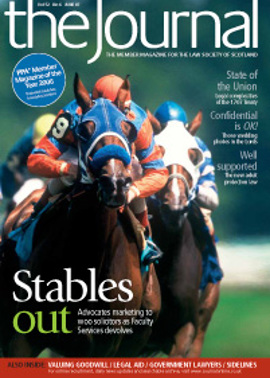Lessons in improvements

Telfer and Others v The Buccleuch Estates Ltd is interesting for many reasons, including the procedure following the tenant’s death shortly before the hearing. To allow the hearing to proceed, the parties agreed that his executors nominate be sisted, but that issue of the court’s order be delayed until they had confirmation. The tenant’s son was authorised to conduct the litigation on the executors’ behalf and the court qualified its findings to record that, while full submissions were made for the landlord, the tenant’s case was not argued to the standard expected of “a qualified contradictor”. The court’s findings must, therefore, be treated cautiously.
Numerous issues were raised, and the court commented that “some of these are far reaching”, it being the first occasion it had dealt with certain provisions of the 2003 Act. Space prevents me from commenting on every matter covered (the court’s note extends to 53 pages), and I concentrate on the following:
Section 34(5) of the 1991 Act carries the right of a tenant to compensation for improvements forward over successive leases. In this case, Auchengruith Farm had been let in 1951 to the tenant and his father. The father died in 1964. The tenant remained in occupation under a new unwritten lease. Glenim Farm was added to the holding in 1965. In 1970 a new written lease was granted to the tenant of the combined holding. The landlords successfully argued that improvements carried out to Auchengruith under the 1951 lease did not carry forward to the 1970 lease as they were not to the same tenant, but failed in an argument that the change in the holding blocked the application of s 34(5).
The landlords also argued that s 34(1) should be narrowly interpreted so that compensation was restricted to improvements carried out by the tenant himself. The tenant’s family partnership had paid for improvements. The court did not accept that this excluded the tenant’s right to compensation.
The court considered the effect of the 2003 Act on compensation write-down agreements. Readers will be familiar with s 43 of the Act, which added s 33A to the 1991 Act. In particular the court considered whether s 33A was retrospective – i.e. whether a write-down agreement which had already expired was superseded by s 33A, reviving the tenant’s right to compensation at the value to an incoming tenant. The question did not, in fact, have to be tackled directly in that the write-down agreement in question related to the installation of electricity, which the court considered was not something which the landlords had been obliged to undertake when the 1951 lease was entered into to fulfil their obligations to provide fixed equipment. Furthermore, the write-down agreement itself had been entered into under the 1951 lease and was already spent by the time of the 1970 lease. The court did, however, observe obiter that “we are satisfied that an agreement validly made under existing statutory provisions does not lose its effect simply because such provisions are repealed. We have not yet been persuaded that the repeals relative to write-down agreements have retrospective effect”. The question therefore remains open.
Section 43 of the 2003 Act also added subs (2A) to s 38 of the 1991 Act (which requires the tenant to give notice before undertaking Part II improvements to preserve his right to compensation). Subsection (2A) disapplies that requirement where the improvement consists of work which a landlord was required to execute at the time the lease was granted in order to fulfil its obligations under the lease. The subjects of the application were a cottage and ground enclosed by a dyke which had been resumed from the tenancy. The tenant rebuilt the dyke in the late 1970s, without serving notice, and claimed compensation following the resumption. Because the whole dyke was rebuilt, not just part of it, the Land Court considered it to be an improvement. It also, interestingly, opined that, because the dyke required renewal in 1977 it could not have been in “a thorough state of repair” at the commencement of the 1970 lease and that, accordingly, the landlords should have rebuilt it then in fulfilment of their obligations under the lease. Accordingly, by application of ss 33A and 38(2A), the tenant was awarded compensation for the improvement. I understand that the landlord did consider appealing this finding, but decided against risking its other successes in the application and there the matter rests. How far, however, the court is entitled to apply the logic which it applied in relation to the dyke in Telfer is a matter for conjecture.
Alasdair G Fox, Anderson Strathern
In this issue
- Court plans with little appeal
- Winning ways
- Forward steps
- Bar to progress
- Dean urges solicitors to stay with fee scheme
- The Union and the law
- Public and confidential
- Adult support: a new generation
- Advice deserts and PDSOs
- Vision 20:20
- Benevolent Fund: a much valued support
- Termites in the basement
- The value of goodwill
- Letters of Engagement Roadshow
- A door almost shut
- Lessons in improvements
- Null from the outset?
- The Tevez affair
- Scottish Solicitors' Discipline Tribunal
- Website reviews
- Book reviews
- Held in check
- Possession undisturbed






